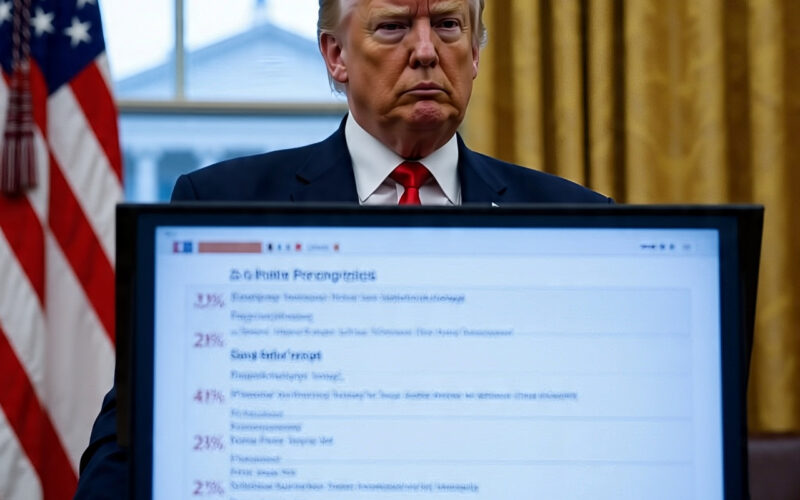#IndiaUSTrade #TrumpTariffs #GlobalTradeTensions #IndianExports #USIndiaRelations #TradeWar2025 #Geopolitics #RussianOil #MakeInIndia #ModiTrump #BilateralTrade #TariffHike
New Delhi / Washington — Former U.S. President and Republican presidential nominee Donald Trump has announced the imposition of a 25% tariff on all Indian imports, effective August 1, 2025, marking a significant escalation in economic tensions between the two democracies. In addition to the tariffs, Trump also warned of additional penalties over India’s continuing purchase of oil and defense equipment from Russia.
The surprise announcement, made via his social media platform, comes in the midst of delicate trade negotiations between India and the United States and just weeks after Indian officials indicated that both sides were close to concluding a “comprehensive and balanced” trade deal.

“India Is a Friend, But Takes Advantage”: Trump
In a strongly worded post, Trump stated, “India is a friend, but they have been taking advantage of the United States for decades. They charge some of the highest tariffs in the world and impose strict non-tariff barriers. Starting August 1, Indian goods entering the U.S. will face a 25% tariff, plus a penalty for their massive purchases of oil and weapons from Russia.”
Trump also reiterated his criticism of India’s trade policies, citing long-standing concerns about unequal tariff structures and restricted market access for American goods. He labeled India’s trade barriers as among the most “obnoxious and protectionist in the world.”
Trade Deal in Limbo
Trump’s move casts a shadow over the ongoing trade talks, which had seen some progress earlier this year. Prime Minister Narendra Modi’s visit to Washington in February 2025 had laid the groundwork for a potential trade pact, with both countries aiming to boost bilateral trade to $500 billion by 2030. However, a final agreement had not yet been signed.
India’s Commerce Ministry had previously expressed optimism, calling the negotiations “constructive and forward-looking.” Key sticking points reportedly included tariffs on agricultural products, data localization rules, and intellectual property rights.
The sudden imposition of tariffs is seen as a major setback to those efforts and could harden India’s position in future negotiations.
Which Sectors Will Be Hit?
The 25% tariff is expected to impact a wide range of Indian exports to the United States, which totaled around $66 billion in 2024. Some of the key sectors likely to be affected include:
-
Pharmaceuticals: India is a major supplier of generic medicines to the U.S., and any tariffs could lead to price hikes.
-
Textiles and Apparel: One of the largest export categories to the U.S., this sector could see reduced competitiveness.
-
Engineering Goods: Machinery, tools, and automotive parts face significant exposure.
-
Jewelry and Gems: Tariffs could dent India’s dominance in this high-margin sector.
According to trade analysts, nearly 87% of Indian exports to the U.S. could face increased costs under the new tariff regime, potentially leading to a loss of $6 to $7 billion annually in export earnings.
U.S. Domestic Concerns Also Rise
While Trump’s tariffs are meant to address trade imbalances, U.S.-based businesses are also sounding alarm bells. American importers, especially small businesses, fear increased costs for raw materials, intermediate goods, and consumer products sourced from India.
Multinational corporations like Adidas, Mercedes-Benz, and other global brands that depend on Indian suppliers have expressed concern about disruptions to supply chains and the potential for product shortages or price increases.
Economists have warned that the tariffs could fuel inflationary pressures in the U.S. and increase costs for American consumers ahead of the November presidential election.
India’s Diplomatic and Economic Response
The Indian government has not yet issued a formal response, but senior officials have indicated that they are “evaluating all options.” While New Delhi is unlikely to retaliate immediately, sources say that reciprocal duties on American goods such as agricultural produce and tech hardware are “under consideration.”
India also finds itself in a strategic dilemma. On one hand, it values its growing partnership with the United States, especially in the Indo-Pacific region. On the other, its long-standing defense and energy ties with Russia are a matter of national security.
Trump’s targeting of India’s Russia linkage—particularly crude oil and S-400 missile system purchases—adds a geopolitical layer to the trade standoff.
Global Repercussions
The imposition of tariffs comes at a time when global trade is already under pressure due to geopolitical uncertainties, inflation, and supply chain realignments. Analysts warn that the Trump move could lead to retaliatory measures from India, strain ties between two key Quad members, and create volatility in emerging markets.
If the tariffs remain in place for an extended period, global supply chains in sectors like pharmaceuticals, apparel, and IT services could be forced to shift, hurting both economies in the long term.
The Road Ahead
With the tariff set to kick in on August 1, there is a small window left for negotiations. Indian and U.S. officials are expected to hold another round of talks in mid-August. However, with Trump’s political base supporting a tough stance on trade, the prospects of an immediate rollback appear slim.
In the meantime, Indian exporters are bracing for impact, U.S. importers are lobbying for exemptions, and investors are closely watching how this high-stakes economic battle between two allies unfolds.
Hashtags:
#IndiaUSTrade #TrumpTariffs #GlobalTradeTensions #IndianExports #USIndiaRelations #TradeWar2025 #Geopolitics #RussianOil #MakeInIndia #ModiTrump #BilateralTrade #TariffHike #EmergingMarkets #IndianEconomy #USImportDuties

